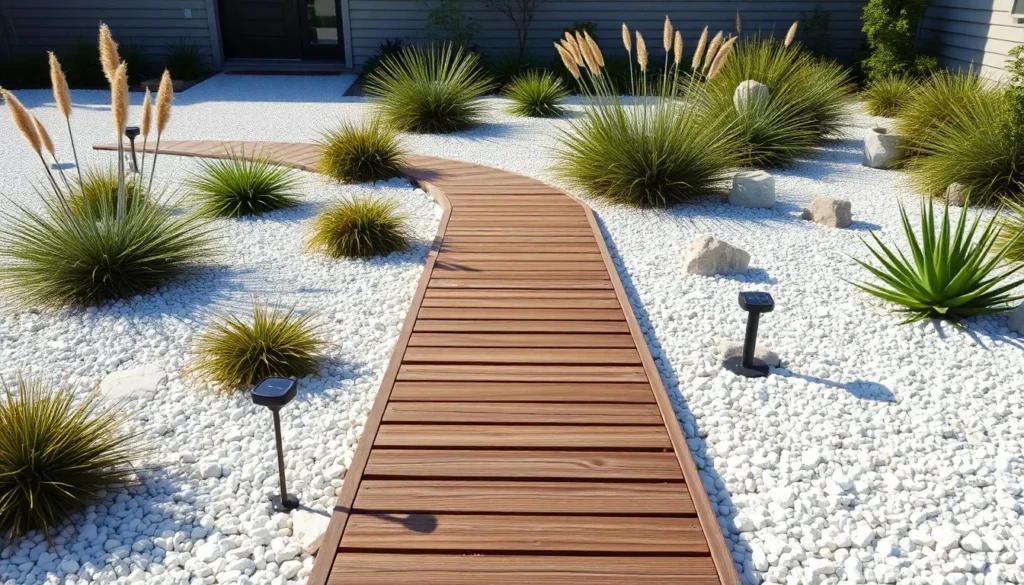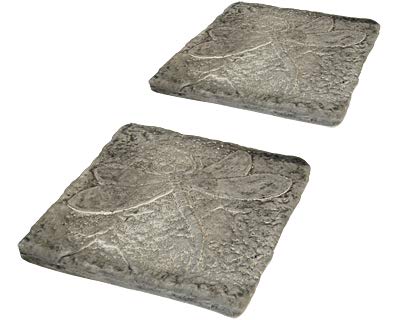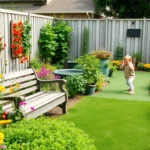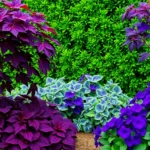We’ve all walked past those stunning front gardens that make us stop and stare. Gravel gardens are quickly becoming one of the most popular landscaping choices for homeowners who want maximum impact with minimal maintenance. They’re not just practical – they’re absolutely gorgeous when done right.
Gravel landscaping offers endless possibilities for creating a front garden that’s both eye-catching and eco-friendly. From modern minimalist designs to cottage-style charm we can transform any front yard into a low-maintenance masterpiece that’ll be the envy of the neighborhood.
Whether you’re dealing with poor soil drainage issues or simply want to reduce your weekend gardening chores gravel garden designs deliver style and substance. We’re about to explore creative ideas that’ll help you design a front garden that looks professionally landscaped while staying within your budget and timeline.
Create a Modern Minimalist Front Garden With White Gravel
White gravel transforms ordinary front gardens into stunning contemporary landscapes that require minimal upkeep. This versatile material creates the perfect foundation for achieving that coveted minimalist aesthetic while maintaining visual impact.
Choose the Right White Gravel Size and Type
Selecting the proper gravel size determines your garden’s visual texture and maintenance requirements. We recommend using 10-20mm white limestone chips for high-traffic areas near walkways and entrances, as they provide excellent stability underfoot. Smaller 5-10mm white marble chips work beautifully for decorative borders and areas around plant features.
Crushed white limestone offers the most cost-effective option for larger garden spaces. This material compacts well and stays in place during heavy rain or wind. White quartzite provides superior durability and maintains its bright appearance longer than softer stone options.
Different gravel types create distinct visual effects in your minimalist design. Angular crushed stone delivers sharp, contemporary lines that complement modern architecture. Rounded pea gravel in white creates softer transitions between planted areas and hardscaping elements.
Design Clean Geometric Patterns
Geometric patterns using white gravel establish strong visual structure in minimalist front gardens. We suggest creating rectangular or square sections separated by steel or aluminum edging strips. These defined spaces allow you to vary gravel textures or introduce contrasting materials like black pebbles or concrete pavers.
Curved pathways balance the rigidity of geometric planting beds. Sweeping arcs of white gravel guide visitors toward your entrance while maintaining the clean aesthetic. Install flexible metal edging to achieve smooth curves that won’t shift over time.
Repetitive geometric elements create rhythm throughout your garden design. Consider placing matching rectangular gravel beds on either side of your main pathway. This symmetrical approach reinforces the minimalist concept while providing visual balance to your front garden composition.
Add Architectural Plants for Structure
Architectural plants serve as living sculptures within your white gravel industry. We recommend using spiky plants like yucca, agave, or ornamental grasses that create dramatic silhouettes against the bright gravel backdrop. These structural elements provide year-round interest without requiring frequent maintenance.
Evergreen shrubs with strong geometric forms complement minimalist gravel gardens perfectly. Boxwood spheres, cylindrical junipers, and pyramidal yews maintain their shape with minimal pruning. Plant these specimens in odd numbers for natural visual appeal while keeping the overall design uncluttered.
Strategic plant placement creates focal points within your white gravel design. Position a single architectural specimen like a Japanese maple or sculptural cactus at the intersection of pathways. This approach draws attention to key areas while maintaining the clean, uncluttered aesthetic that defines modern minimalist landscaping.
Design a Mediterranean-Style Gravel Garden

Moving from minimalist designs, we’ll explore how gravel creates authentic Mediterranean landscapes that transport you to coastal Europe. Warm tones and drought resistant elements define this timeless garden style.
Select Warm-Toned Gravel Colors
Choose warm-toned gravel for patios and pathways to evoke that authentic Mediterranean atmosphere we all crave. Gravel comes in various textures and colors, adding remarkable depth and visual interest to your garden space.
Experiment with different sizes and shades of gravel to create textured and contrasting landscapes that mirror the natural Mediterranean terrain. Terracotta-colored pea gravel works beautifully for main pathways, while golden limestone chips create stunning accent borders.
Blend multiple warm tones together for maximum visual impact. Cream-colored gravel paired with rust-red stone chips mimics the sun-baked earth of Mediterranean hillsides perfectly.
Incorporate Drought-Resistant Plants
Select drought-resistant plants such as succulents and cacti that thrive in Mediterranean climates without constant watering. These plants offer visual appeal while requiring minimal maintenance throughout the growing season.
Plant agave specimens as dramatic focal points among your gravel beds. Potted palms and various succulent varieties create authentic Mediterranean character while conserving water naturally.
Position plants strategically to complement your gravel’s warm tones. Silver-leafed lavender and rosemary bushes provide aromatic elements that enhance the sensory Mediterranean experience.
Add Terracotta Accents and Features
Use terracotta pots and planters to add classic Mediterranean touches throughout your gravel garden design. These containers serve both decorative and functional purposes, housing herbs or small ornamental plants beautifully.
Incorporate water features like tiered fountains, reflecting pools, or misters to enhance the ambiance with soothing sounds. These elements create tranquil atmospheres while providing cooling effects during warm weather.
Install warm earth-toned furniture and decorative elements like stone walls or wood fences to complete your Mediterranean theme. Outdoor lighting highlights your garden’s features and creates inviting evening ambiance for entertaining guests.
Build a Japanese-Inspired Zen Front Garden
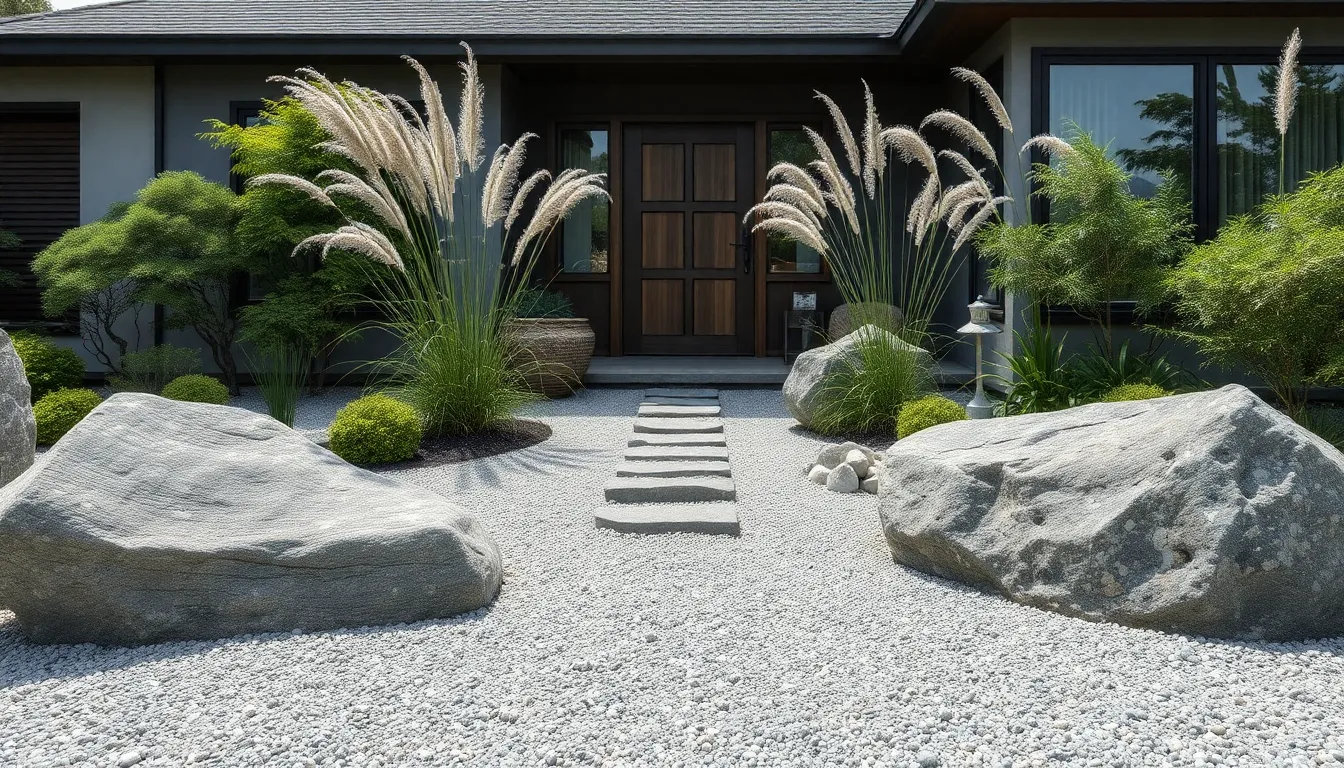
Creating a serene Japanese-inspired front garden brings tranquil beauty to your home’s entrance. This timeless design philosophy emphasizes simplicity, natural elements, and peaceful contemplation through carefully arranged gravel, rocks, and plants.
Use Raked Gravel Patterns for Tranquility
Raked gravel patterns form the foundation of authentic Zen garden design, creating symbolic representations of water and waves. We recommend using 20mm gravel for optimal raking consistency, as this size maintains pattern definition while remaining stable underfoot. Creating flowing lines and circular patterns around key features helps guide the eye through your garden space.
Different raking techniques produce distinct visual effects that enhance your garden’s meditative qualities. Straight parallel lines evoke calm water surfaces, while curved patterns around rocks mimic flowing streams. Regular maintenance of these patterns becomes a mindful practice that connects you with your garden’s peaceful energy.
Position Statement Rocks and Boulders
Statement rocks serve as focal points that represent mountains and islands in traditional Japanese garden philosophy. We suggest selecting weathered stones with interesting textures and natural patinas that complement your gravel’s color palette. Positioning larger boulders asymmetrically creates visual balance while maintaining the organic feel essential to Zen design.
Strategic rock placement follows the principle of odd numbered groupings, with three or five stones creating more natural compositions than even arrangements. Partially burying rocks gives them an established appearance as if they’ve emerged naturally from the earth over time. These permanent features anchor your design and provide structure for seasonal plant additions.
Plant Ornamental Grasses and Bamboo
Ornamental grasses and bamboo introduce gentle movement and soft textures that contrast beautifully with hard gravel surfaces. Pampas grass offers dramatic height and feathery plumes that sway gracefully in breezes, while compact varieties like fountain grass provide subtle texture without overwhelming smaller spaces. Bamboo creates natural privacy screens and produces soothing sounds when wind moves through its leaves.
Plant selection should emphasize low maintenance varieties that thrive in well-drained gravel conditions. Positioning these plants near statement rocks creates layered compositions that feel both structured and natural. Their changing seasonal colors and textures keep your Zen garden visually interesting throughout the year while maintaining its peaceful character.
Combine Mixed Gravel Colors for Visual Interest

Moving beyond single-color schemes, we can transform our front gardens into captivating displays by mixing different gravel colors strategically. This approach creates sophisticated landscapes that catch the eye while maintaining the low-maintenance benefits we love about gravel gardens.
Layer Different Gravel Textures
Texture contrast adds remarkable depth to our gravel landscapes when we combine smooth and rough materials thoughtfully. We can layer smooth river pebbles alongside coarser angular gravel to create visual zones that guide the eye through our garden design.
Visual appeal increases dramatically when we alternate between fine and chunky textures in different areas. Smooth pebbles work beautifully as pathways or around plant bases, while rougher gravel provides excellent drainage and creates interesting shadows throughout the day.
Maintenance benefits emerge when we use 20mm gravel size for high-traffic areas, as this size remains durable under foot traffic while smaller textures can accent borders and decorative zones.
Create Natural River Rock Borders
Natural borders using large river rocks provide structure and definition to our gravel areas while maintaining an organic appearance. We position these substantial stones around planting beds or along pathway edges to create clear boundaries without harsh lines.
Rustic charm develops when we select river rocks in complementary colors to our chosen gravel palette. These weathered stones add authentic texture and create focal points that break up expansive gravel areas naturally.
Durability advantages make river rock borders practical long-term investments since they require minimal maintenance and withstand weather changes better than many alternatives.
Balance Cool and Warm Tones
Harmonious landscapes result when we thoughtfully combine cool gray and blue gravels with warm beige and brown tones. This balance prevents our gardens from feeling too stark or overly busy while creating sophisticated color relationships.
Mood enhancement occurs through strategic color placement, where cool tones like gray can create calming spaces near seating areas while warm browns and terracottas add energy around entrance points.
Color combinations work best when we use darker grays, beiges, and whites together, as these create sophisticated palettes that complement both modern and traditional home styles while remaining timeless in appeal.
Install Low-Maintenance Succulent and Gravel Gardens

Combining succulents with gravel creates the ultimate low maintenance front garden that thrives with minimal care. These drought tolerant partnerships offer year round visual appeal while requiring far less water and attention than traditional landscaping.
Select Hardy Succulent Varieties
Choose resilient succulent species that can withstand your local climate conditions without frequent intervention. Aloe varieties provide architectural structure with their thick fleshy leaves and occasional dramatic flower spikes. Agave plants create stunning focal points with their bold rosette shapes and sculptural presence. Echeveria offers delicate pastel hues and compact growth habits perfect for smaller garden spaces.
Evaluate your climate zone before selecting exact succulent types to ensure long term success. Cold hardy varieties like hens and chicks survive freezing temperatures while maintaining their attractive appearance. Desert species such as barrel cactus and prickly pear excel in hot dry conditions with minimal supplemental watering.
Group succulents by water requirements to create efficient irrigation zones within your gravel garden. Xerophytic species need watering only during extended drought periods. Semi drought tolerant varieties may require occasional deep watering during summer months.
Design Raised Gravel Beds
Create elevated planting areas using raised beds that improve drainage while making garden maintenance more accessible. These structures prevent waterlogged soil conditions that can damage succulent root systems. Use 20mm gravel size for pathways to ensure durability and comfortable walking surfaces throughout your garden design.
Install proper drainage layers beneath your raised beds using coarse gravel or crushed stone as a foundation. This prevents water from pooling around plant roots during heavy rainfall periods. Border materials like metal edging or natural stone provide clean defined edges that complement your gravel surfaces.
Calculate bed dimensions based on your available space and desired plant arrangements. Shallow beds measuring 6 to 8 inches deep work well for most succulent varieties. Wider beds allow for creative plant groupings and easier access for routine maintenance tasks.
Plan for Seasonal Color Changes
Incorporate flowering succulents that provide bursts of color during exact seasons throughout the year. Ficaria verna ‘Coppernob’ creates cheerful carpets of sunset orange blooms that brighten spring garden displays. Sedum varieties offer late season flowers in pink yellow and red shades during autumn months.
Select plants with colorful foliage that changes with temperature fluctuations and seasonal light conditions. Purple echeveria deepens its hues during cooler weather while maintaining attractive rosette shapes. Silver and blue agave varieties provide consistent color contrast against warm toned gravel backgrounds.
Stagger bloom times across different succulent species to maintain visual interest from spring through fall seasons. Early flowering varieties like ice plants provide spring color while late blooming sedums extend the display into winter months.
Create Defined Pathways Through Gravel Landscaping
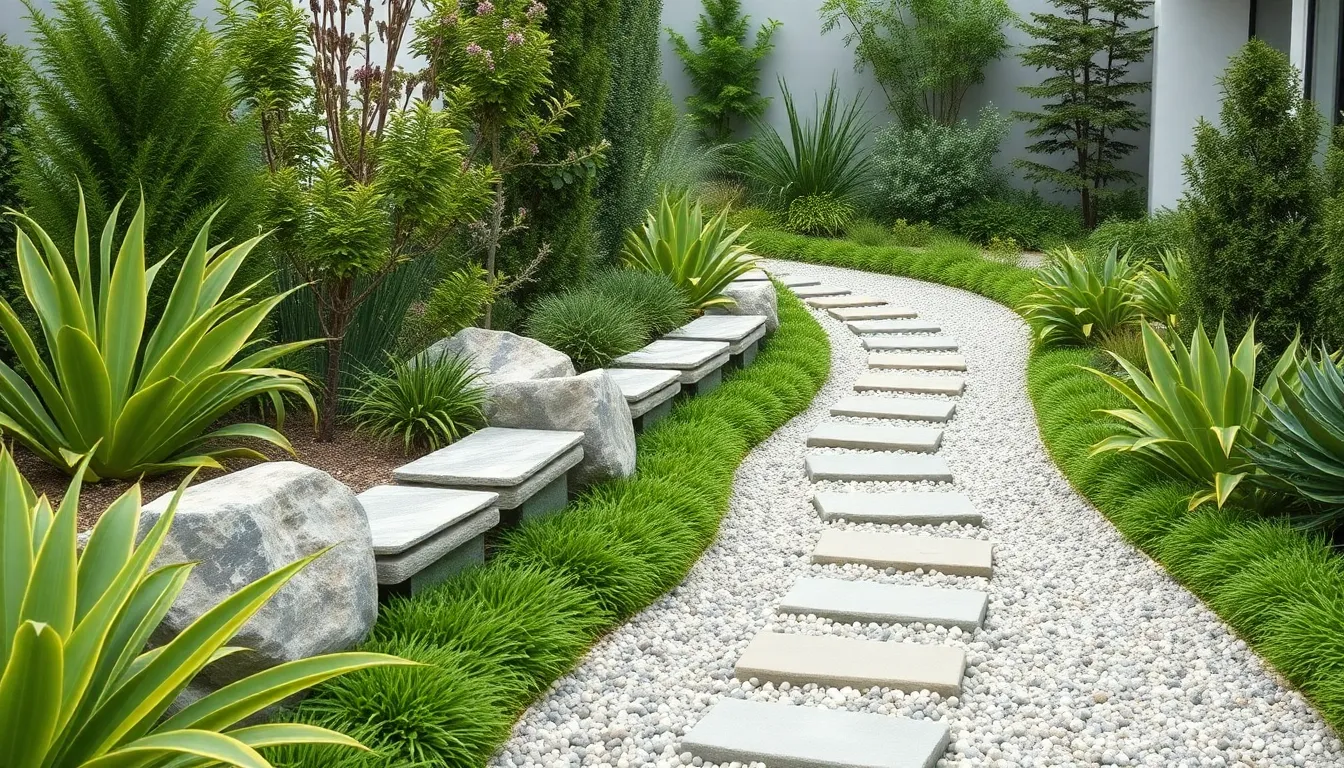
Pathway creation through gravel landscapes transforms functional garden routes into stunning design features. We’ll explore how to use 20mm sized gravel for optimal walking comfort and vehicle stability while incorporating traffic-resistant plants like acaena and creeping thyme.
Design Stepping Stone Walkways
Stepping stones create visual rhythm while providing stable footing through gravel gardens. Natural stone materials like sandstone or granite offer durability and complement the organic texture of surrounding gravel beds.
Strategic placement ensures comfortable walking distances of 18-24 inches between each stone. We recommend choosing stones with slightly textured surfaces to prevent slipping during wet conditions.
Installation depth should position stones flush with or slightly above the gravel surface. This prevents gravel migration onto walking surfaces while maintaining clean sight lines throughout the pathway.
Size variation adds visual interest when mixing circular and rectangular stepping stones. Larger stones at pathway intersections create natural stopping points and decision zones for garden navigation.
Build Raised Wooden Boardwalks
Wooden boardwalks elevate pathways above gravel surfaces while adding rustic charm to contemporary landscapes. Cedar and pressure-treated lumber provide weather resistance for long-term outdoor exposure.
Construction height of 2-4 inches above gravel level prevents moisture damage while creating architectural definition. Support posts every 4-6 feet ensure structural stability for daily foot traffic.
Board spacing of 1/4 inch between deck planks allows proper drainage while preventing debris accumulation. This gap width accommodates natural wood expansion during seasonal temperature changes.
Curved sections soften harsh linear designs and guide visitors through garden focal points. We achieve gentle curves using flexible composite materials or by cutting traditional lumber at strategic angles.
Install Decorative Edging Materials
Edging materials define gravel boundaries while preventing spillage onto adjacent surfaces. Steel, aluminum, and composite options provide clean lines that complement modern architectural styles.
Installation depth requires burying edging materials 3-4 inches below surface level for proper stability. This depth prevents shifting during freeze-thaw cycles and maintains consistent border appearance.
Material selection impacts both aesthetics and functionality across different gravel applications:
| Edging Material | Durability | Cost | Best Use |
|---|---|---|---|
| Steel | 15-20 years | $$$ | Contemporary designs |
| Aluminum | 10-15 years | $$ | Curved pathways |
| Composite | 8-12 years | $ | Budget-friendly borders |
| Natural stone | 20+ years | $$$$ | Traditional landscapes |
Height adjustment allows edging to sit flush with gravel surfaces or slightly above for enhanced definition. We recommend 1-2 inches of visible edging height for optimal gravel containment without creating trip hazards.
Add Water Features to Gravel Front Gardens
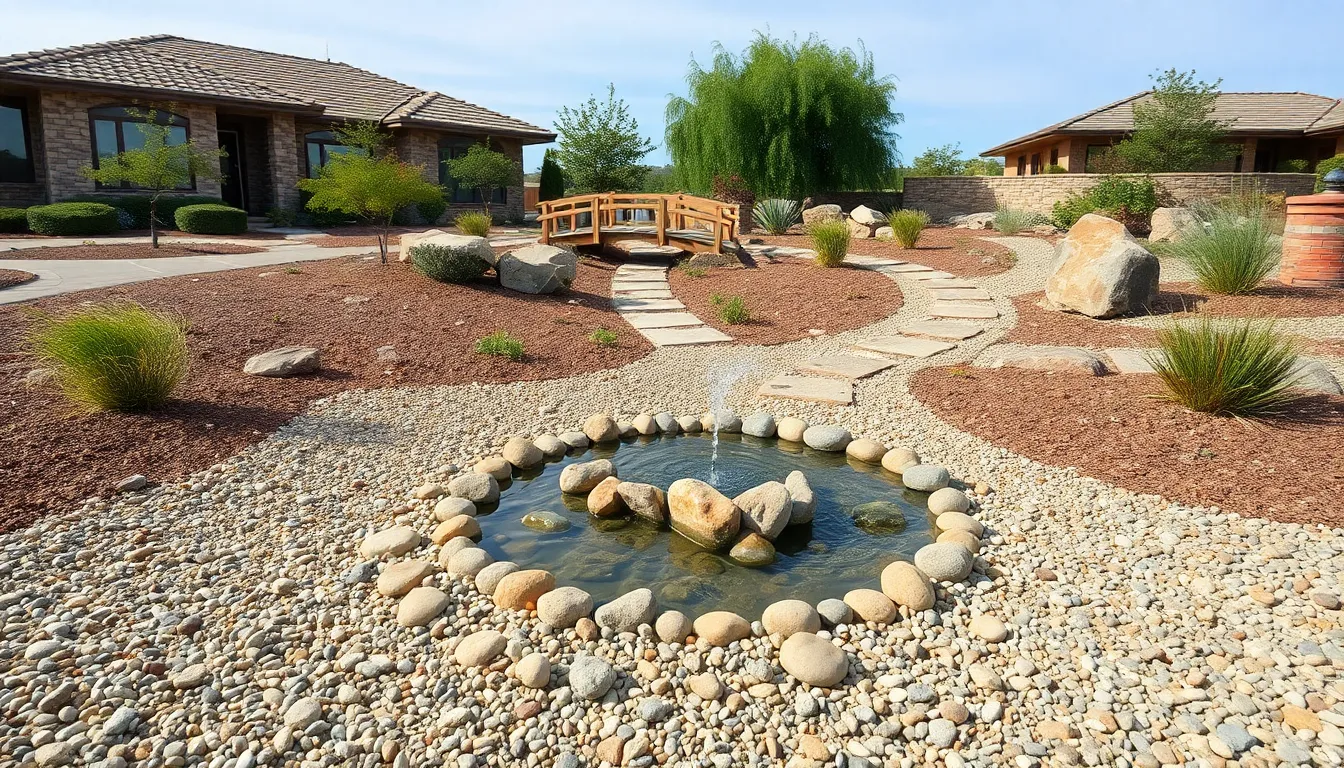
Water elements transform gravel gardens from simple landscaping into ever-changing outdoor spaces that engage all your senses. These features complement the natural drainage properties of gravel while adding movement and tranquility to your front garden design.
Install Small Fountain Elements
Installing small fountain elements brings soothing sounds and visual appeal to your gravel industry. We recommend positioning compact bubble fountains or tiered water features as focal points within your gravel beds to create natural gathering spaces.
Solar powered fountains work exceptionally well in gravel gardens since they require no electrical connections and can be easily repositioned as your design evolves. These eco friendly options typically provide 6-8 hours of operation on sunny days while maintaining consistent water circulation.
Stone or ceramic fountain bowls integrate seamlessly with gravel surroundings and create gentle water sounds that mask neighborhood noise. We suggest selecting fountains with basin diameters between 18-24 inches to maintain proper scale within residential front gardens.
Maintenance becomes effortless when you choose self contained fountain units that recirculate water through built in pumps. These systems prevent water waste while ensuring your fountain operates efficiently throughout the growing season.
Create Dry Creek Bed Designs
Creating dry creek bed designs adds natural water flow patterns without requiring actual water sources or complex drainage systems. We use varying gravel sizes to mimic authentic riverbeds, starting with larger river rocks along the edges and transitioning to smaller pebbles in the center channel.
Meandering pathways through your gravel garden simulate natural creek formations while providing functional walkways between planted areas. These designs work particularly well when following your property’s natural slope and drainage patterns.
Strategically placed boulders along your dry creek bed create visual anchors and suggest natural water obstacles found in mountain streams. We recommend using local stone materials to ensure your design feels indigenous to your exact geographic region.
Bridge elements spanning your dry creek bed add architectural interest while maintaining the illusion of flowing water. Small wooden or stone bridges create charming focal points that invite exploration of your gravel garden space.
Position Reflecting Pool Accents
Positioning reflecting pool accents creates elegant mirrors that double your garden’s visual impact while adding sophisticated water elements to gravel landscapes. We install shallow pools using preformed liners or concrete forms that integrate naturally with surrounding gravel surfaces.
Still water surfaces reflect architectural plants and sky views, effectively expanding your garden’s perceived size through optical illusions. These pools work best in partially shaded locations where water remains clear and algae growth stays minimal.
Raised reflecting pools using stone or concrete borders elevate water features above gravel level, creating dramatic design statements that serve as garden centerpieces. We typically construct these pools 6-12 inches above ground level for optimal visual impact.
Integrated lighting beneath reflecting pools transforms your gravel garden into evening entertainment spaces with shimmering water effects. LED strip lights or submersible fixtures create magical ambiance while highlighting your water feature’s architectural qualities after sunset.
Incorporate Lighting for Evening Appeal
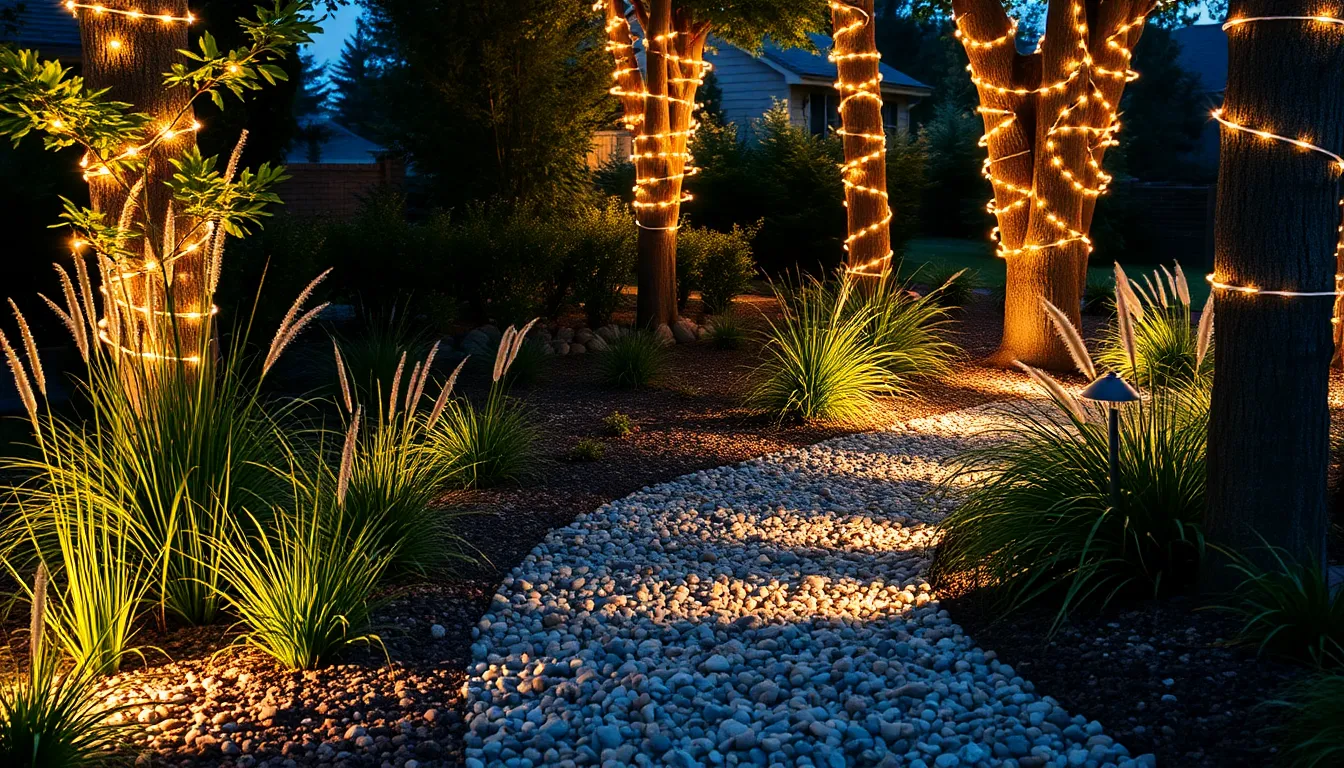
Evening lighting transforms our gravel front gardens into captivating displays that extend their beauty beyond daylight hours. Strategic illumination enhances the texture and visual appeal of our carefully designed gravel landscapes while creating welcoming pathways for visitors.
Install Solar Path Lighting
Solar path lighting offers an eco-friendly solution that guides visitors along our gravel pathways without requiring electrical wiring or ongoing energy costs. We recommend positioning solar fixtures every 6-8 feet along the main walkways to provide adequate illumination while highlighting the garden’s design elements. Modern solar path lights store energy during daylight hours and automatically activate at dusk, making them perfect for low-maintenance gravel gardens.
Quality solar fixtures withstand weather conditions and provide consistent lighting throughout the evening hours. We suggest selecting lights with warm LED bulbs that complement the natural tones of our gravel surfaces. Stainless steel or bronze finishes blend seamlessly with outdoor environments while resisting corrosion over time.
Add Uplighting for Featured Plants
Uplighting transforms our featured plants into dramatic focal points that draw attention to the garden’s most beautiful elements. We position LED spotlights at ground level to cast light upward through ornamental grasses, architectural plants, or specimen trees, creating stunning silhouettes against evening skies. This technique works particularly well with plants like yucca, bamboo, and ornamental grasses that have interesting structural forms.
Adjustable LED fixtures allow us to direct light precisely where we want emphasis, highlighting the textures and shapes of our chosen plants. Low-voltage lighting systems provide safety while delivering professional results that enhance our garden’s evening atmosphere. We recommend using warm white lights (2700K-3000K) to create inviting ambiance that complements the natural colors of our gravel and plantings.
Create Ambient Industry Illumination
Ambient lighting establishes a warm and inviting atmosphere throughout our gravel front gardens using string lights, lanterns, or integrated LED strips. We can drape weather-resistant string lights along fencing, wrap them around tree trunks, or suspend them between posts to create magical overhead illumination. Solar-powered string lights eliminate the need for electrical connections while providing hours of gentle lighting.
Lantern-style fixtures placed strategically throughout the garden add visual interest while casting soft pools of light across gravel surfaces. We recommend choosing fixtures that complement our garden’s overall design theme, whether modern, Mediterranean, or rustic. Integrated LED strips hidden within raised bed edges or pathway borders provide subtle accent lighting that defines garden boundaries without overwhelming the natural beauty of our gravel landscapes.
Design Seasonal Interest With Ornamental Grasses

Ornamental grasses transform gravel gardens into ever-changing landscapes that change throughout the year. We’ll show you how to select and arrange grasses that thrive in gravel conditions while providing continuous visual appeal.
Choose Grasses That Complement Gravel
Fountain grass creates stunning textural contrast against smooth gravel surfaces with its cascading plumes that sway gracefully in the breeze. We recommend pampas grass for dramatic height and movement, as it thrives in well-draining gravel conditions and produces feathery plumes that catch sunlight beautifully. Selecting grasses like feather reed grass, maiden grass, and blue fescue ensures compatibility with gravel gardens since these varieties prefer the excellent drainage that gravel provides.
Consider the mature size of each grass variety when planning your layout to prevent overcrowding in the future. Native ornamental grasses adapt best to local climate conditions and require less maintenance once established in gravel settings. Mixing different grass textures creates depth, with fine-textured grasses like buffalo grass contrasting beautifully with broader-leafed varieties like miscanthus.
Plan for Year-Round Texture and Movement
Evergreen grasses maintain structure during winter months when deciduous plants lose their foliage. We suggest incorporating grasses that offer seasonal color changes, such as little bluestem that shifts from blue-green in summer to bronze-red in fall. Planning for diverse bloom times ensures continuous interest, with early summer bloomers like June grass followed by late-season varieties like purple fountain grass.
Seed heads provide winter interest long after growing seasons end, creating architectural elements that look stunning dusted with frost or snow. Combining grasses with different growth patterns ensures movement at various heights throughout your gravel garden. Selecting varieties that retain their form through winter prevents bare spots and maintains the garden’s appeal during dormant months.
Maintain Proper Spacing and Growth Patterns
Spacing grasses according to their mature spread prevents competition and maintains the airy, informal look characteristic of successful gravel gardens. We recommend allowing 18-24 inches between smaller grass clumps and up to 4 feet for larger specimens like pampas grass. Proper spacing ensures adequate air circulation, reducing disease problems common in crowded plantings.
Regular division every 3-4 years keeps grass clumps healthy and prevents them from overwhelming neighboring plants. Trimming back grasses in late winter or early spring maintains tidy growth patterns and encourages fresh growth. Creating natural drifts rather than rigid rows mimics how grasses grow in nature and enhances the organic feel of gravel garden designs.
Conclusion
Transforming your front garden with gravel opens up endless possibilities for creating a stunning low-maintenance industry that reflects your personal style. Whether you’re drawn to the clean lines of modern minimalism the warmth of Mediterranean designs or the tranquility of Japanese-inspired spaces gravel provides the perfect foundation for your vision.
We’ve explored how strategic plant placement creative lighting answers and thoughtful color combinations can elevate your gravel garden from simple to spectacular. The beauty lies in gravel’s versatility – it adapts seamlessly to different design themes while requiring minimal upkeep throughout the seasons.
Your gravel front garden represents more than just a landscaping choice; it’s an investment in sustainable outdoor living that delivers year-round appeal. With proper planning and the right design elements you’ll create an inviting entrance that enhances your home’s curb appeal while giving you more time to enjoy your outdoor space rather than maintaining it.
Frequently Asked Questions
What are the main benefits of gravel gardens?
Gravel gardens offer excellent drainage, require minimal maintenance, and provide year-round visual appeal. They’re eco-friendly, budget-friendly, and versatile enough to suit various design styles from modern minimalist to Mediterranean themes. Additionally, they reduce watering needs and eliminate many traditional gardening chores while creating attractive landscapes.
What size gravel is best for front garden pathways?
For pathways, 20mm gravel is ideal as it provides comfort and stability for walking. In high-traffic areas, 10-20mm white limestone chips work well, while smaller 5-10mm marble chips are perfect for decorative borders. The larger size prevents gravel from sticking to shoes and creates a more comfortable walking surface.
How do I create a Mediterranean-style gravel garden?
Use warm-toned gravel in terracotta and golden limestone colors. Incorporate drought-resistant plants like succulents and cacti, add terracotta pots, and consider water features. Complete the look with warm earth-toned outdoor furniture and ambient lighting to create an inviting Mediterranean atmosphere perfect for relaxation.
What plants work best in gravel gardens?
Drought-resistant plants thrive in gravel gardens, including succulents (aloe, agave, echeveria), ornamental grasses (fountain grass, pampas grass), architectural plants like yucca, and bamboo. These plants require minimal water and maintenance while providing year-round structure and seasonal interest to complement the gravel landscape.
How do I maintain proper drainage in gravel gardens?
Create raised gravel beds with proper drainage layers to prevent water pooling. Use coarser gravel or crushed stone as a base layer, followed by landscape fabric, then your decorative gravel on top. This system ensures excellent drainage while preventing weeds and maintaining the garden’s low-maintenance appeal.
Can I mix different gravel colors and textures?
Yes, mixing gravel creates captivating visual displays. Layer different textures like smooth river pebbles with angular gravel for depth. Balance cool and warm tones for harmony, and use natural river rock borders for structure. This approach adds visual interest while maintaining the low-maintenance benefits of gravel landscaping.
What lighting options work best for gravel gardens?
Solar path lighting is eco-friendly and perfect for illuminating pathways—place fixtures every 6-8 feet. Use uplighting for dramatic plant focal points and ambient lighting through string lights or lanterns for atmosphere. Choose quality solar fixtures that complement your garden’s design style for beautiful evening appeal.
How do I create a Japanese Zen gravel garden?
Use 20mm gravel for raked patterns that symbolize water and waves. Place statement rocks and boulders in odd-numbered groupings as focal points. Add ornamental grasses and bamboo for gentle movement and texture. Keep the design simple and balanced to maintain the meditative, tranquil qualities of Zen aesthetics.

